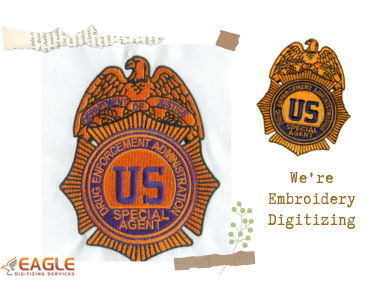Smooth Sailing with Digitized Embroidery on Difficult Fabrics
Embroidery, a craft steeped in history and tradition, has embraced the digital age with fervor. The art of digitized embroidery combines technology with creativity, enabling crafters to produce intricate designs with precision. However, when it comes to embroidering on thick and difficult fabrics, the task requires an extra layer of expertise. This article delves into the nuances of digitized embroidery, specifically focusing on the challenges and techniques associated with thick and difficult materials.
Challenges of Embroidering on Thick Fabrics
Identifying Thick and Difficult Fabrics
Thick fabrics, such as denim, leather, and velvet, present unique challenges for embroidery. These materials are often more durable and less flexible than their lighter counterparts, making them difficult to work with. Recognizing these fabrics is the first step in tackling the embroidery process effectively.
Common Issues Faced with Thick Fabrics
Embroidering on thick fabrics can lead to a myriad of issues, from broken needles to distorted designs. The rigidity of these materials can cause the fabric to bunch or shift, resulting in misaligned stitches and puckering. Additionally, the increased thickness requires stronger needles and threads, which can be difficult to manage.
Why These Fabrics Are Worth the Extra Effort
Despite the challenges, thick fabrics are worth the extra effort due to their durability and the striking results they can produce. Embroidery on such materials often results in bold, vibrant designs that stand out. The durability of thick fabrics ensures that the embroidered design lasts longer, making it ideal for items that undergo heavy use, such as jackets, bags, and upholstery.
Choosing the Right Materials
Selecting the Best Threads for Thick Fabrics
When it comes to thick fabrics, not all threads are created equal. Polyester and rayon threads are ideal alternatives due to their durability and shine. They are less likely to break under the strain of thick materials and provide a professional finish. Metallic threads can also add a touch of elegance but require careful handling to avoid breakage.
Needles: Finding the Perfect Fit
Choosing the right needle is crucial for successful embroidery on thick fabrics. Heavier materials require larger, stronger needles, such as a size 90/14 or even 100/16. These needles can penetrate the fabric without bending or breaking, ensuring smooth stitching and consistent results.
Stabilizers: Your Best Friend in Embroidery
Stabilizers provide the necessary support to prevent the fabric from shifting or stretching during embroidery. For thick fabrics, a heavy-duty cutaway stabilizer is often the best choice. It offers the stability needed for dense designs and remains in place even after washing, preserving the integrity of the embroidery.
Preparing Thick Fabrics for Embroidery
Pre-Washing and Ironing: Essential Steps
Pre-washing thick fabrics removes any sizing or chemicals that might interfere with the embroidery process. It also allows the fabric to shrink before stitching, preventing any distortion of the design later. Ironing the fabric ensures a smooth surface, making it easier to hoop and stitch.
Marking Your Design Without Damaging the Fabric
Marking your design on thick fabrics requires careful consideration. Water-soluble pens or tailor’s chalk are good options, as they can be easily removed without leaving a trace. Avoid using markers that could bleed or stain the fabric, as this could ruin your hard work.
Using Temporary Adhesives: Pros and Cons
Temporary adhesives can help keep thick fabrics in place while embroidering, reducing the risk of shifting. However, they can also leave a residue or cause the fabric to stiffen. It's important to test the adhesive on a small area first and use it sparingly to avoid any negative effects.
Design Considerations for Thick Fabrics
Simplifying Complex Designs for Better Results
Thick fabrics require a simplified approach to design. Complex patterns with numerous small details can get lost in the texture of the fabric. Opt for bold, simple designs that can stand out against the material's thickness, ensuring clarity and impact.
Adjusting Stitch Density for Thick Materials
Stitch density is a critical factor when working with thick fabrics. Too many stitches can cause the fabric to become too stiff and lead to puckering. Adjusting the density to suit the material ensures the design lays flat and maintains its shape.
Choosing the Right Embroidery Software
The right embroidery software can make a significant difference in your projects. Look for software that offers customization options for stitch density, thread types, and needle settings. This flexibility allows you to tailor your designs specifically for thick fabrics, ensuring optimal results.
Setting Up Your Embroidery Machine
Calibrating Your Machine for Thick Fabrics
Proper calibration of your embroidery machine is essential for handling thick fabrics. Adjust the presser foot height to accommodate the material's thickness, and ensure the feed dogs can grip the fabric without causing damage.
Hoop Selection: Finding the Right Size and Type
Selecting the appropriate hoop is crucial for keeping the fabric taut and in place. A sturdy, heavy-duty hoop is ideal for thick fabrics, providing the necessary support to prevent shifting. Make sure the hoop is large enough to accommodate the entire design without needing to re-hoop mid-project.
Tension Settings: Getting It Just Right
Proper tension settings ensure that the thread flows smoothly through the fabric without causing breaks or loops. Test your machine's tension on a scrap piece of the same fabric before starting your project, adjusting as needed to achieve a balanced stitch.
Techniques for Successful Embroidery on Thick Fabrics
Tackling Bulky Seams and Layers
Bulky seams and layers can pose a significant challenge when embroidering thick fabrics. Use a walking foot or a Teflon foot to help the fabric move smoothly under the needle. Trimming excess fabric from the seams can also reduce bulk and improve stitch quality.
Avoiding Puckering and Distortion
To avoid puckering, ensure that the fabric is hooped tightly and the stabilizer is appropriate for the fabric's weight. Using a basting stitch to secure the fabric and stabilizer together can also help prevent movement and distortion.
Managing Thread Breaks and Skipped Stitches
Frequent thread breaks and skipped stitches can be frustrating. Ensure your needle is sharp and appropriate for the fabric, and check that your thread is of high quality. Regularly clean your machine to remove any lint or debris that could interfere with stitching.
Special Tips for Difficult Fabrics
Embroidering on Leather: What You Need to Know
Leather requires special care due to its non-woven nature. Use a leather needle and a sturdy polyester thread. Avoid dense designs, as too many perforations can weaken the leather. A tear-away stabilizer is often the best choice for leather projects.
Handling Velvet and Corduroy with Care
Velvet and corduroy have a nap that can be challenging to work with. Hoop these fabrics with the nap facing up to avoid flattening it. Use a water-soluble topping to prevent the stitches from sinking into the fabric's pile, ensuring a clean and crisp design.
Tips for Embroidering Heavy Denim
Denim is durable but can be thick and rigid. Use a heavy-duty needle and polyester thread for best results. A tear-away stabilizer works well with denim, providing the necessary support without adding too much bulk.
Troubleshooting Common Problems
Dealing with Broken Needles
Broken needles are a common issue with thick fabrics. Ensure you're using a needle appropriate for the fabric's weight and thickness. Regularly check for signs of wear and replace needles frequently to avoid breakage.
Fixing Misaligned Designs
Misaligned designs can occur if the fabric shifts during embroidery. Secure the fabric and stabilizer well, and use basting stitches to keep everything in place. Double-check the alignment before starting your design to ensure accuracy.
Solutions for Thread Bunching and Loops
Thread bunching and loops are often caused by improper tension settings or poor-quality thread. Adjust your machine's tension and use high-quality threads designed for embroidery. Regularly clean your machine to prevent lint buildup, which can also cause these issues.
Enhancing Your Embroidery with Special Effects
Using Metallic and Specialty Threads
Metallic and specialty threads can add a unique touch to your embroidery. These threads require a slower stitching speed and a larger needle to prevent breakage. Use a top-quality thread and stabilizer to support the additional weight and texture.
Adding Texture with Foam and 3D Embroidery
Foam and 3D embroidery techniques can create stunning, textured designs. Use a thicker foam for more pronounced effects, and adjust your stitch density to ensure the foam is well-covered. Test on a scrap piece before committing to your final design.
Incorporating Appliqués and Patches
Appliqués and patches can enhance your embroidery with additional color and texture. Securely stitch the appliqué to the fabric, using a zigzag or satin stitch to cover the edges. This technique is especially useful for adding large designs without increasing stitch count.
Caring for Embroidered Thick Fabrics
Washing and Drying: Dos and Don’ts
Proper care is essential to maintain the quality of embroidered thick fabrics. Hand wash or run a gentle machine cycle with mild detergent. Avoid wringing out the fabric, as this can distort the embroidery. Air drying is preferred to maintain the fabric's shape.
Ironing and Storing Embroidered Items
Iron embroidered items on the reverse side02 to avoid flattening the stitches. To protect the fabric and embroidery, use a pressing cloth. Store items flat or rolled, rather than folded, to prevent creases that could damage the design.
Repairing Damaged Embroidery
Damaged embroidery can often be repaired with careful stitching. Use matching thread and a fine needle to mend any loose or broken stitches. For more extensive damage, consider adding a patch or appliqué to cover the area.
Digitized embroidery on thick and difficult fabrics presents unique challenges, but with the right techniques and materials, the results can be spectacular. Whether you're a seasoned professional or a passionate hobbyist, understanding these intricacies will enhance your embroidery projects and expand your creative horizons.



